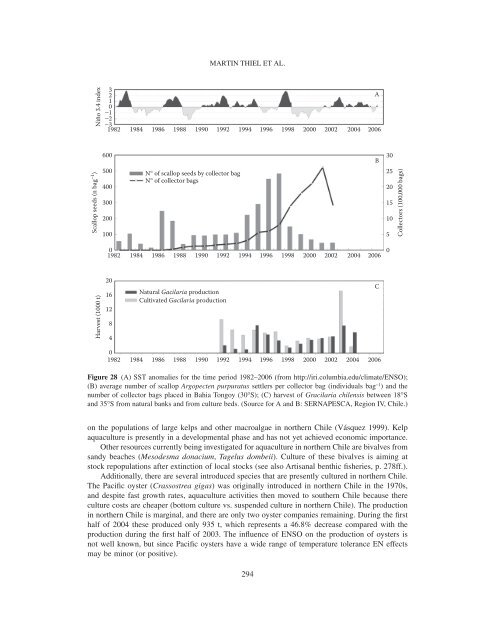MARTIN THIEL ET AL.Niño 3.4 index32A10−1−2−31982 1984 1986 1988 1990 1992 1994 1996 1998 2000 2002 2004 2006Scallop seeds (n bag −1 )600500400300200100N° <strong>of</strong> scallop seeds by collector bagN° <strong>of</strong> collector bagsB30252015105Collectors (100,000 bags)01982 1984 1986 1988 1990 1992 1994 1996 1998 2000 2002 2004 20060Harvest (1000 t)20161284Natural Gacilaria productionCultivated Gacilaria productionC01982 1984 1986 1988 1990 1992 1994 1996 1998 2000 2002 2004 2006Figure 28 (A) SST anomalies for <strong>the</strong> time period 1982–2006 (from http://iri.columbia.edu/climate/ENSO);(B) average number <strong>of</strong> scallop Argopecten purpuratus settlers per collector bag (individuals bag −1 ) <strong>and</strong> <strong>the</strong>number <strong>of</strong> collector bags placed in Bahia Tongoy (30°S); (C) harvest <strong>of</strong> Gracilaria <strong>chile</strong>nsis between 18°S<strong>and</strong> 35°S from natural banks <strong>and</strong> from culture beds. (Source for A <strong>and</strong> B: SERNAPESCA, Region IV, Chile.)on <strong>the</strong> populations <strong>of</strong> large kelps <strong>and</strong> o<strong>the</strong>r macroalgae in nor<strong>the</strong>rn Chile (Vásquez 1999). Kelpaquaculture is presently in a developmental phase <strong>and</strong> has not yet achieved economic importance.O<strong>the</strong>r resources <strong>current</strong>ly being investigated for aquaculture in nor<strong>the</strong>rn Chile are bivalves froms<strong>and</strong>y beaches (Mesodesma donacium, Tagelus dombeii). Culture <strong>of</strong> <strong>the</strong>se bivalves is aiming atstock repopulations after extinction <strong>of</strong> local stocks (see also Artisanal benthic fisheries, p. 278ff.).Additionally, <strong>the</strong>re are several introduced species that are presently cultured in nor<strong>the</strong>rn Chile.The Pacific oyster (Crassostrea gigas) was originally introduced in nor<strong>the</strong>rn Chile in <strong>the</strong> 1970s,<strong>and</strong> despite fast growth rates, aquaculture activities <strong>the</strong>n moved to sou<strong>the</strong>rn Chile because <strong>the</strong>reculture costs are cheaper (bottom culture vs. suspended culture in nor<strong>the</strong>rn Chile). The productionin nor<strong>the</strong>rn Chile is marginal, <strong>and</strong> <strong>the</strong>re are only two oyster companies remaining. During <strong>the</strong> firsthalf <strong>of</strong> 2004 <strong>the</strong>se produced only 935 t, which represents a 46.8% decrease compared with <strong>the</strong>production during <strong>the</strong> first half <strong>of</strong> 2003. The influence <strong>of</strong> ENSO on <strong>the</strong> production <strong>of</strong> oysters isnot well known, but since Pacific oysters have a wide range <strong>of</strong> temperature tolerance EN effectsmay be minor (or positive).294
THE HUMBOLDT CURRENT SYSTEM OF NORTHERN AND CENTRAL CHILEO<strong>the</strong>r species introduced to <strong>the</strong> coast <strong>of</strong> Chile are abalone, originating from California <strong>and</strong>Japan. These have been mainly cultured in l<strong>and</strong>-based facilities, but due to an increasing production<strong>and</strong> limited holding capacities on l<strong>and</strong>, sea-based culture (as already established in sou<strong>the</strong>rn Chile)is also considered for nor<strong>the</strong>rn-<strong>central</strong> Chile. The production <strong>of</strong> abalones increased from 1 t in1998 to 342 t in 2005, <strong>and</strong> for <strong>the</strong> year 2006 it is expected that <strong>the</strong> Chilean abalone industry willproduce >500 t. Only in Region IV, <strong>current</strong>ly five abalone production centres are established <strong>and</strong>an additional five centres have solicited permits to initiate new aquaculture activities during 2006.The present abalone production in Chile is mainly based on <strong>the</strong> red abalone (Haliotis rufescens).However, <strong>the</strong> Japanese abalone (H. discus hannai), which has a better market value, is also raised,but to a lesser degree since culture technology has higher requirements (<strong>and</strong> costs) than those forred abalone.Although <strong>the</strong> l<strong>and</strong>-based abalone culture is not directly affected by variations in environmentalconditions, ENs may have severe effects on abalone culture because <strong>the</strong>y can produce strong impactson <strong>the</strong> population <strong>of</strong> large kelp, <strong>the</strong> main food resource presently used in abalone culture. The lackin supply <strong>of</strong> fresh food algae may produce serious bottlenecks in <strong>the</strong> culture <strong>of</strong> abalone. Some <strong>of</strong><strong>the</strong>se problems are occurring presently <strong>and</strong> <strong>the</strong> National Fisheries Service (SERNAPESCA) isconcerned with <strong>the</strong> overexploitation <strong>of</strong> kelp, restricting <strong>the</strong> extraction from natural kelp beds <strong>and</strong>promoting research for cultivation <strong>and</strong> management <strong>of</strong> seaweeds. This scenario presents importantchallenges for applied research in <strong>the</strong> near future.In general, aquaculture in nor<strong>the</strong>rn <strong>and</strong> <strong>central</strong> Chile does not reach <strong>the</strong> levels it has in sou<strong>the</strong>rnChile. Some <strong>of</strong> <strong>the</strong> main reasons for this are related to <strong>the</strong> fact that <strong>the</strong> coast <strong>of</strong> nor<strong>the</strong>rn Chile is(1) mostly exposed to wave action <strong>and</strong> (2) is strongly affected by important interannual variationsin oceanographic conditions. Future efforts should probably focus on <strong>the</strong> development <strong>of</strong> l<strong>and</strong>basedculture facilities <strong>and</strong> integrated <strong>system</strong>s where animals <strong>and</strong> algae are produced in combination(Chopin et al. 2001).Conservation <strong>of</strong> marine biodiversity<strong>and</strong> Marine Protected AreasThe HCS extending from Ecuador to sou<strong>the</strong>rn Chile is considered as one <strong>of</strong> <strong>the</strong> large marineeco<strong>system</strong>s for high-priority attention (Boersma et al. 2004). The growing use <strong>of</strong> coastal areas byhuman activities is also increasingly threatening marine biodiversity in <strong>the</strong> HCS. The most importantthreats are overfishing, aquaculture, pollution by sewage <strong>and</strong> mining activities, run<strong>of</strong>fs <strong>of</strong> chemicalsused for agriculture, oil spills <strong>and</strong> tourism activities (Vásquez et al. 1999, Fernández et al. 2000).All countries, including Chile, that have ratified <strong>the</strong> Convention on Biological Diversity (CBD)treaty agreed to develop a network <strong>of</strong> Marine Protected Areas (MPAs, as defined by IUCN 1994)to ultimately protect 10% <strong>of</strong> <strong>the</strong> marine environments by 2012, based on an eco<strong>system</strong> approach(Wood 2006). However, <strong>the</strong> actual establishment rate <strong>of</strong> MPAs (4.5% annual increase) reveals that<strong>the</strong> work plan is unrealistic <strong>and</strong> will not be achieved before <strong>the</strong> second half <strong>of</strong> this century (Wood2006). The Chilean case is a paradox as its economic exclusive zone (EEZ) corresponds to 17.8%<strong>of</strong> <strong>the</strong> Latin-American EEZ <strong>and</strong> is three times larger than its terrestrial territory (~18% <strong>of</strong> which isalready protected; Pauchard & Villarroel 2002). However, only 0.03% <strong>of</strong> <strong>the</strong> Chilean EEZ (0.67%<strong>of</strong> <strong>the</strong> territorial sea) is protected as MPAs (CONAMA personal communication). Fur<strong>the</strong>r, only14% <strong>of</strong> <strong>the</strong> surface area <strong>of</strong> <strong>the</strong>se MPAs are located within <strong>the</strong> HCS <strong>of</strong> nor<strong>the</strong>rn <strong>and</strong> <strong>central</strong> Chile(18°S to 41°S). Considering that ~95% <strong>of</strong> <strong>the</strong> Chilean population is located between 18°S <strong>and</strong> 41°S<strong>and</strong> <strong>the</strong> growing human impact in coastal areas, this zone represents one <strong>of</strong> <strong>the</strong> greatest challengesfor marine conservation.The Chilean fisheries management policy, through creation <strong>of</strong> Management <strong>and</strong> ExploitationAreas (AMERBs) for benthic resources from coastal habitats, is focusing on economically important295










